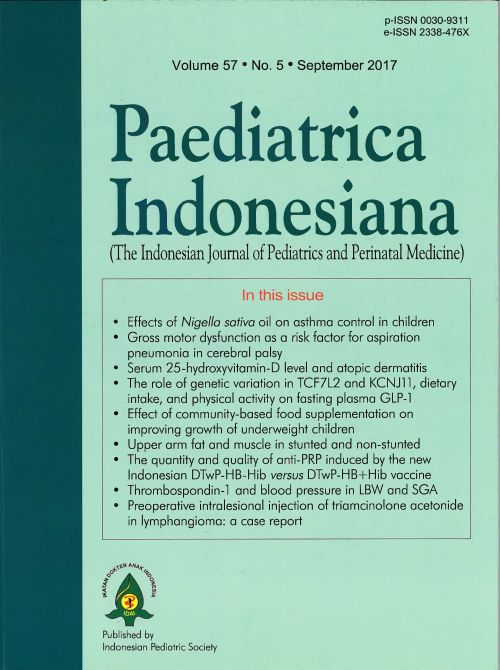Upper arm fat and muscle in stunted and non-stunted children aged 0-24 months
DOI:
https://doi.org/10.14238/pi57.5.2017.252-61Keywords:
stunting, overweight, obesity, upper arm fat area, upper arm muscle area, upper arm fat percentageAbstract
Background The prevalence of stunting in Indonesia is high, with particularly negative impacts on health during childhood as well as adolescence. Stunting impacts the health of children as well as adults, especially with regards to future obesity. Therefore, evaluating body composition of stunted children before 2 years of age is necessary.
Objective To compare upper arm fat and muscle measurements in stunted and non-stunted children aged 0-24 months of age.
Methods We analyzed secondary data of the Division of Nutrition and Metabolic Disease, Department of Child Health, Universitas Gadjah Mada Medical School, Yogyakarta which were collected using cluster random sampling from the Yogyakarta Special Province. We compared upper arm fat area (UFA), including the upper arm fat area estimate (UFE) and the upper arm fat percentage (UFP), as well as upper arm muscle area (UMA) and upper arm muscle area estimate (UME), among stunted and non-stunted children aged 0-24 months.
Results We analyzed 2,195 children. The prevalence of stunting was 354/2,195 (16.1%). The UFA, UFE, and UFP among stunted children were significantly lower compared to non-stunted children aged 7-12 months [UFA: 4.48 vs. 5.05 cm2 (P <0.001), respectively; UFE: 4.88 vs. 5.55 cm2 (P <0.001), respectively; and UFP: 30.82 vs. 32.58% (P = 0.03), respectively]. The UMA in children aged 7-12 months was also significantly lower in stunted than in non-stunted children [11.31 vs. 11.79 cm2 (P = 0.02), respectively], as well as in children aged 13-24 months [11.05 vs. 11.75 cm2 (P <0.001), respectively]. In addition, the UME in children aged 13-24 months was significantly lower in stunted compared to non-stunted children [10.50 vs. 11.18 cm2 (P <0.001), respectively].
Conclusion The UFA in children aged 7-12 months is smaller in stunted than in non-stunted children, whereas UMA in children aged 7-12 months and 13-24 months was smaller in stunted compared to non-stunted children.
References
2. Balitbangkes Kementerian Kesehatan RI. Riset Kesehatan Dasar (Riskesdas). 2013; [cited 2013 Feb 11]; Available from: http://terbitan.litbang.depkes.go.id/penerbitan/index.php/blp/catalog/book/64.
3. Stewart CP, Iannotti L, Dewey KG, Michaelsen KF, Onyango AW. Contextualising complementary feeding in a broader framework for stunting prevention. Maternal Child Nutr. 2013;9 Suppl 2:27–45.
4. Chomtho S, Fewtrell MS, Jaffe A, Williams JE, Wells JC. Evaluation of arm anthropometry for assessing pediatric body composition: evidence from healthy and sick children. Pediatr Res. 2006;59:860–5.
5. Rolland-Cachera MF, Brambilla P, Manzoni P, Akrout M, Sironi S, Del Maschio A, et al. Body composition assessed on the basis of arm circumference and triceps skinfold thickness: a new index validated in children by magnetic resonance imaging. Am J Clin Nutr. 1997;65:1709-13.
6. Silva DR, Ribeiro AS, Pavão FH, Ronque ERV, Avelar A, Cyrino ES. Validity of the methods to assess body fat in children and adolescents using multi-compartment models as the reference method: a systematic review. Rev Assoc Med Bras. 2013;59:475-86.
7. Adair LS, Guilkey DK. Age-specific determinants of stunting in Filipino children. J Nutr. 1997;127:314-20.
8. United Nations, Department of Technical Co-operation for Development and Statistical Office. 1986. How to weigh and measure children. Assessing the nutritional status of young children in household surveys. Preliminary version. New York. National Health and Nutrition Examination Survey III. 1998. Body measurement (Anthropometry). Rockville MD, 20850.
9. National Health and Nutritional Examnination Survey (NHNES). Anthropometry Procedural Manual, 2007.
10. Madiyono B, Moeslichan MS, Sastroasmoro S, Budiman I, Purwanto SH. Perkiraan besar sampel. In: Sastroasmoro S, Ismael S, editors. Dasar-dasar metodologi penelitian klinis. Jakarta: CV Sagung Seto; 2010. p. 302-31.
11. Fernald LC, Neufeld LM. Overweight with concurrent stunting in very young children from rural Mexico: prevalence and associated factors. Eur J Clin Nutr. 2007;61:623-32.
12. Unicef. Definition of the indicators. 2016. [cited 2017 May 24]; Available from: http://www.unicef.org/infobycountry/stats_popup2.html
13. BÃ¥genholm G, Nasher AA, Kristiansson B. Stunting and tissue depletion in Yemeni children. Eur J Clin Nutr. 1990;44:425-33.
14. Friedman JF, Phillips-Howard PA, Mirel LB, Terlouw DJ, Okello N, Vulule JM, et al. Progression of stunting and its predictors among school-aged children in western Kenya. Eur J Clin Nutr. 2005;59:914–22.
15. Tanner S, Leonard WR, Reyes-Garcıa V, TAPS Bolivia Study Team. The consequences of linear growth stunting: influence on body composition among youth in the Bolivian Amazon. Am J Phys Anthropol. 2014;153:92–102.
16. Lipsberga G, Kažoka D. Upper-arm anthropometry as nutritional assessment in preschool children in Latvian population. 2016. Papers Anthropol. 2016:XXV/2:25–35.
17. Briend A, Khara T, Dolan C. 2015. Wasting and stunting-similarities and differences: policy and programmatic implications. Food Nutr Bul. 2015;36(1Suppl):S15-23.
18. Jumbe T, Comstock SS, Hahn SL, Harris WS, Kinabo J, Fenton JI. Whole blood levels of the n-6 essential fatty acid linoleic acid are inversely associated with stunting in 2-to-6 year old Tanzanian children: a cross-sectional study. PLoS One. 2016;11: e0154715.
Downloads
Published
How to Cite
Issue
Section
License
Authors who publish with this journal agree to the following terms:
Authors retain copyright and grant the journal right of first publication with the work simultaneously licensed under a Creative Commons Attribution License that allows others to share the work with an acknowledgement of the work's authorship and initial publication in this journal.
Authors are able to enter into separate, additional contractual arrangements for the non-exclusive distribution of the journal's published version of the work (e.g., post it to an institutional repository or publish it in a book), with an acknowledgement of its initial publication in this journal.
Accepted 2017-10-16
Published 2018-01-05














